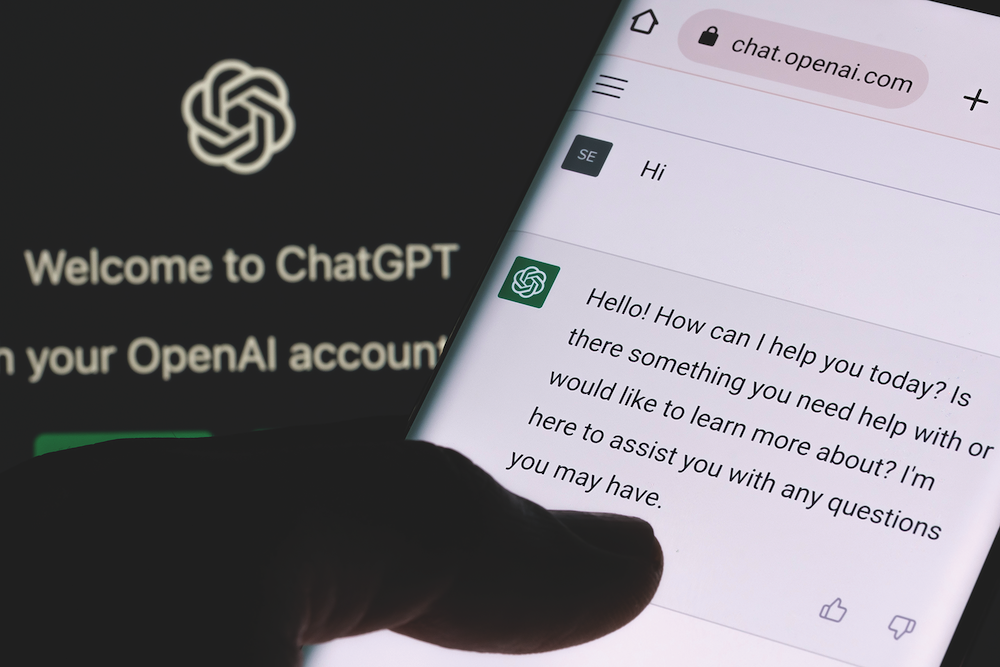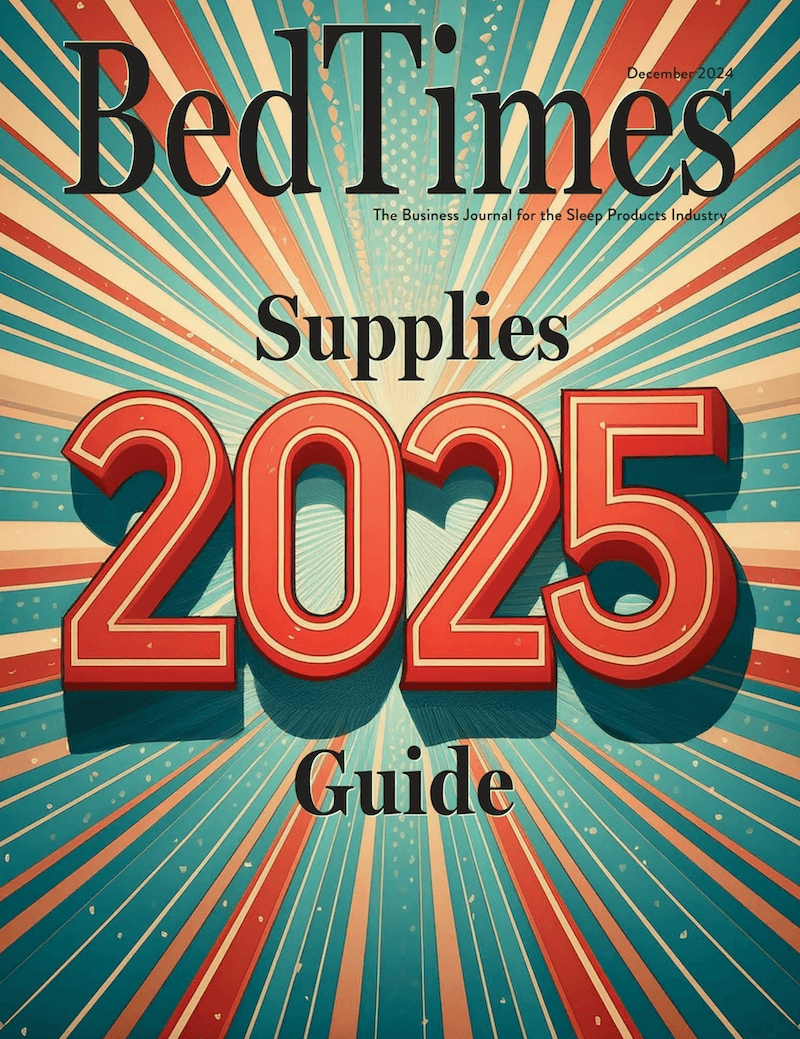How’s this for a sign of the times? What once belonged in sci-fi films is now writing them. In 2026, the world’s first AI-animated feature-length film will premiere at the Cannes Film Festival. It’s a perfect example of how artificial intelligence is reshaping entire industries from filmmaking to bedding. The September 2024 issue of BedTimes explored AI in the bedding industry and its potential applications. Since the publication of that article, something big has happened.

For the first time since 2015, Google’s global search engine market share dropped below 90% due to competition from platforms like ChatGPT. That’s huge news considering Google’s global domination since the early 2000s. Although the Mountain View, California-based technology company isn’t becoming obsolete anytime soon, the shift demonstrates how people are incorporating AI into their daily lives.
Keep reading to learn how AI has evolved over the past year and how experts see the future — at least for now.
From Search Engine to Action-Taker: AI Agents in Retail
Since OpenAI’s public release of AI chatbot ChatGPT on Nov. 30, 2022, the software has gone through several updates. The San Francisco-based company’s Agent Mode, released on July 17, is ushering in a new era of capabilities, signaling how AI will change from a search engine to an agent.
A recent article on Microsoft Source, an online publication by the Seattle-based technology company, explains the concept. “Think of agents as the apps of the AI era,” says Charles Lamanna, corporate vice president of business and industry at Copilot. “Just as we use different apps for various tasks, agents will begin to transform every business process, revolutionizing the way we work and manage our organizations.”
Retail consultant and writer Bob Phibbs concurs. “AI is moving from search engine to action-taker,” he says. In his newsletter, Phibbs, also known as The Retail Doctor, recently wrote about his experience with a pilot from Google Labs that he used to search for a reservation at a Mexican restaurant. Google called the restaurant on his behalf, inquired about availability and got back in touch with him. It might be puzzling to think about what finding a place to eat has to do with the bedding industry, but Phibbs said it’s a sign that “customer expectations are shifting fast. Consumers will come to expect instant answers and seamless interactions. If your business isn’t keeping up, they’ll move on to one that is.” And that won’t be true only of bedding retailers, but also for suppliers and manufacturers.
Earlier this year, cloud-based customer relationship management software company Salesforce, headquartered in San Francisco, released its sixth annual Connected Shoppers Report, sharing insights into the state of retail. The report revealed 76% of retailers plan to increase their investment in AI within the next year and 75% of retailers stated that AI agents will be essential to remain competitive. More telling, 39% of all shoppers already use AI for product discovery. Even 63% of Gen Z shoppers are comfortable with AI agents making purchases on their behalf, which could include purchases like mattresses and other bedding accessories.
One company investing heavily in AI is Bursa, Turkey-based mattress and foam machinery manufacturer Elektroteks. The company’s upcoming AI Agent will help manage predictive maintenance, service schedules and batch production. According to Dhruvin Patel, global sales manager at Elektroteks, the agent is aimed at improving efficiency and reducing downtime.
Dark Factories and Autonomous Manufacturing
In the September issue of BedTimes, we covered the current landscape of automation machinery and how manufacturers are integrating AI for better speed and efficiency.
One innovation is dark factories, named for the idea that some manufacturing facilities could operate fully autonomously with no need for human intervention. According to the website TexSpace Today, a dark factory “is a production site where machines handle every task — assembly, inspection and logistics — eliminating the need for human presence. Without workers, there’s no need for lighting, heating or breaks, reducing energy costs and boosting efficiency.”
Elektroteks is also piloting AI-driven dark factories, designed to operate with minimal human intervention. “Our goal is continuous innovation — enhancing speed, flexibility and integration based on customer needs and market demands,” Patel says. “With AI at the center, future systems will be smarter, more predictive and even more sustainable.”
What makes sense for one manufacturer, however, might not make sense for another. The bedding industry — much like the people it serves — is not one size fits all.
Is This Real Life — or Just a Fantasy?
While many marvel at the speed at which artificial intelligence can provide information, beware of AI hallucinations. According to Google, “AI hallucinations are incorrect or misleading results that AI models generate.” The errors can be caused by data biases or lack of information. For more complex tasks, it’s a best practice to double-check the information AI provides to prevent any mistakes.

How AI-Powered Robots Are Changing the Factory Floor
Making dark factories possible requires machines to run autonomously and also a new kind of worker — robots. According to the International Federation of Robotics, China installed 290,367 robots in 2022, a number that outpaces the United States and Japan combined and a figure that accounts for 52% of the world’s total.
Robots, though, are still expensive. But a September article in The New York Times, “Rented Robots Get the Worst Jobs and Help Factories Keep the Humans” by Farah Stockman, covered the rising popularity of robots-for-rent services. Some companies are renting robots to do labor-intensive tasks such as wrapping pallets in plastic and lifting boxes. Rather than laying workers off, employees are getting promoted or reassigned to better jobs within factories, leading to higher worker retention.
A March 2025 NPR article highlighted the work of student Moo Jin Kim at Stanford University, who is working on robots that run on AI, with a teachable neural network so that it learns as it performs tasks — repetitive or otherwise — and becomes more efficient over time.
Digital Twins: Simulating Products and Processes
Another type of technology that becomes more efficient over time? Digital twins. According to Google’s AI-integrated search, “a digital twin is a dynamic, virtual representation of a physical object, process or system, continuously updated with real-time data from its real-world counterpart.” Although the first digital twin was created by NASA in the 1960s for the Apollo missions, the term has surged in popularity over the past few years. Digital twins — paired with AI — have a variety of applications. For example, a social media influencer could create a virtual replica of themselves to create videos, brand deals and content so they could free up their time for other tasks. So, what does that mean for bedding producers?
The world’s first AI-integrated mattress was released in March 2018 by Paris-based, AI-powered product company Heka-AI. The mattress automatically sensed and adapted to users’ needs. Since then, an array of AI-integrated sleep products has been released, but now, the concept of digital twins is bringing it to a new level.
San Francisco-based company Eight Sleep wants to use AI to “fix” sleep. The company plans to create a digital twin of its users to run endless scenarios before bed every night and compare the data against its 1 billion hours of biometric data. This will pair with its product, which adjusts temperature, elevation and integrated soundscapes, in pursuit of giving its users “the perfect night’s sleep every night.”
Key Dates
An overview of recent innovations in AI.

Japanese robotics company Fanuc launches the world’s first dark factory.

Heka-AI releases the world’s first
AI-integrated mattress.

OpenAI releases ChatGPT-5 with faster responses and improved reasoning capabilities.

It’s unknown when we will achieve the Singularity (when artificial intelligence surpasses human intelligence) but some experts say it could be as soon as 2030.
Sustainable Innovation with AI and Digital Twins
Digital twins are also useful on the manufacturing side. In August, a Renewable Carbon News article stated that digital twins “allow researchers and companies to simulate scenarios, optimize resource use and predict wear or failure. In practice, this extends product lifespans, enables smarter recycling and establishes feedback loops between production and use.”
Digital twins could help create more durable and sustainable products, while also reducing the need for physical prototypes, trimming even more waste. Taking it a step further, AI can help create more green products on a molecular level. Citrine Informatics, a company that specializes in generative AI for materials and chemical development, simulates and tests materials before creating a physical prototype, shortening research times and leading to faster development. While the Redwood City, California-based company doesn’t create bedding products, this type of AI could have a profound impact in the bedding industry to help create more biodegradable products, greener foams and recyclable textiles.
Ludwigshafen, Germany-based BASF, the largest chemical company in the world, has also been using machine learning to help it innovate and speed up research.
The Future of Sleep: Hyper-Personalized AI Ecosystems
Above are the emerging potential uses of AI in the bedding industry. But what about future possibilities? ChatGPT has a few ideas. For one, hyper-personalized sleep ecosystems. Bedding systems could also generate adaptive environments with noise and scents to help sleepers fall and stay asleep. Think about sheets, pillows and mattresses that sync together to create an ideal environment, such as adjusting the pillow height when someone rolls over or cooling the mattress during deep sleep. ChatGPT said that beds integrated with AI could become early diagnostic systems by detecting biomarker changes like breathing irregularities or temperature fluctuations to identify sleep apnea or other conditions. Looking even further into the future, ChatGPT speculates on neuro-responsive bedding, with EEG-enabled pillows that could read brain activity and adjust conditions to ease people into deeper sleep.
Navigating the Downsides: Data, Bias, and Recycling Challenges
AI applications in the bedding industry make it seem like sleep is headed for a utopian future. And while new technology has its upsides, it’s important to be aware of potential downsides, too. For example, AI-integrated mattresses and toppers have built-in sensors or chips that may make mattresses more difficult to recycle at the end of their useful life.
Also, when it comes to sleep data, it’s critical to avoid bias. It’s key to train AI systems on a variety of people who are diverse in ages, gender and those with and without sleep disorders to have a more accurate trove of information. Sleep is incredibly personal and unique to every individual.
From more cost-efficient manufacturing to assisting consumers in finding the perfect sleep product, AI can — and will — change the bedding industry. Although innovations are exciting, it’s important to remember that sleep is highly personal and, in one way or another, will always require a human touch.






